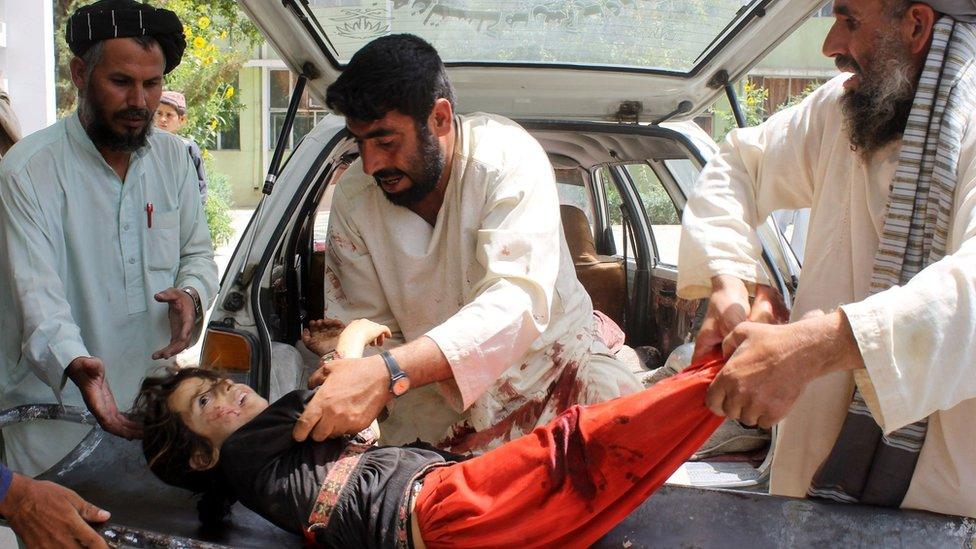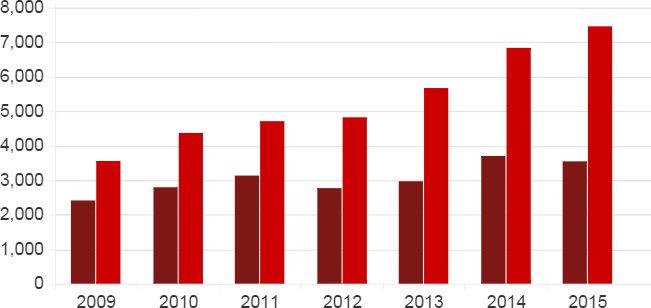Afghan civilian death and injuries 'reach record high'
- Published

Children accounted for one in four casualties in 2015
The number of people killed and wounded in conflict in Afghanistan rose in 2015 to the highest level yet recorded, the UN mission in the country says.
There were 11,002 casualties in total, with a 37% increase in women affected and 14% for children.
The Afghan government accused the Taliban of targeting civilians, especially women, to spread fear.
The UN's human rights chief said such "brutal and unprincipled attacks" were forbidden under international law.
"This is happening with almost complete impunity," Zeid Ra'ad al-Hussein said in the report, external produced by the UN Assistance Mission for Afghanistan (Unama). "The perpetrators of the violations... must be held to account."
Since the withdrawal of international troops from Afghanistan began after 2011 and the official end of Nato's combat mission in December 2014 , the number of civilian casualties has risen year on year.

The report blamed ground fighting in and around populated areas, along with suicide bombings and other attacks in cities for the 3,545 deaths and 7,457 injuries it recorded.
This is a 4% increase on last year's figures.
Although there were 156 fewer civilian deaths compared to 2014, the number of injuries soared, pushing the overall casualty figure to the highest level since the UN started keeping records in 2009.
"Unprecedented numbers of children were needlessly killed and injured last year," Unama's Danielle Bell said in a statement, external.
The Afghan government said the UN's report did not accurately reflect how many civilians were killed in suicide attacks as it only covered "high-conflict areas" whereas its statistics covered the whole country.

Crossfire testimony

The Taliban briefly seized Kunduz in September
A brother of a man who had gone out to fetch water for his family in Kunduz city on 1 October told the UN: "He called my mobile and said, 'Hey brother… I was shot in my stomach… I don't know who shot me… my injuries are serious… I can see pieces of my own intestines on my motorcycle.'
"After that, the line went dead... no-one could reach the site of the incident to take him back because of the fighting. His body remained in the streets for three days, until my relatives could recover it and bury him."
The Taliban over-ran the northern Afghan city of Kunduz in September and left several weeks later after a counter-attack.

The number of causalities caused by militants fell, but still constituted 62% of the total, Unama said.
The government blamed the drop on the fact that civilians in areas of consistent shelling, attacks and harassment by the Taliban had fled their homes.
The UN report said anti-government elements were increasingly using tactics to deliberately cause civilian harm and there was an indiscriminate use of pressure-plate-triggered improvised explosive devices (IEDs).
The number of casualties inflicted by pro-government forces, including Nato, which continues to provide some military support, rose by 42% compared to 2014.
These were mainly attributable to the Afghan security forces during ground engagements and aerial operations.
Unama said it continued to document human rights abuses carried out by pro-government armed groups in 2015 which included "deliberate killings, assaults, extortion, intimidation and theft".